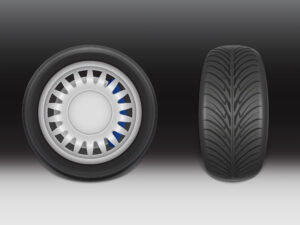How to Check Car Tyre Manufacturing Date: A Complete Guide

Understanding how to check car tyre manufacturing date is a vital part of car maintenance that every vehicle owner should know. Tyres naturally degrade over time, and their safety, performance, and longevity diminish as they age. Knowing how to check the manufacturing date of your tyres ensures you’re driving on fresh, reliable tyres that contribute to a safer driving experience.
In this comprehensive guide, we’ll walk you through how to check car tyre manufacturing date by decoding tyre date codes. We’ll also discuss the significance of tyre age, outline factors that impact a tyre’s lifespan, and provide tips for identifying and replacing old tyres. Let’s get started!
Understanding Tyre Manufacturing Date Codes
If you’re wondering how to check car tyre manufacturing date, the answer lies in the code imprinted on your tyre’s sidewall. This date code gives you an instant understanding of the tyre’s age and helps you make informed decisions about replacements.
- What is a Tyre Manufacturing Date Code?
The tyre manufacturing date code is a four-digit number located on the sidewall, typically following the “DOT” symbol. This code tells you the week and year of manufacture. Learning how to check car tyre manufacturing date helps you quickly assess the tyre’s freshness. - Example of a Tyre Date Code
Imagine you see a code like DOT XXXXXXX3421. The last four digits, “3421,” mean that the tyre was produced in the 34th week of 2021. - Why It’s Important
Tyre manufacturers advise replacing tyres after six years, regardless of how much tread remains. By knowing how to check car tyre manufacturing date, you can ensure you’re not driving on aged tyres that may compromise safety.
Using how to check car tyre manufacturing date as part of regular vehicle maintenance adds peace of mind and keeps you informed about your tyres’ condition and safety.
Step-by-Step Guide: How to Read Tyre Date Codes
Learning how to check car tyre manufacturing date is easy once you know where to look and what to look for. Follow these simple steps:
- Locate the Tyre Sidewall: The manufacturing date code is on the sidewall, the curved part of the tyre connecting the tread to the bead. This part holds all the critical tyre information.
- Find the DOT Code: The DOT code usually starts with “DOT” and is followed by a string of letters and numbers.
- Identify the Last Four Digits: The final four digits in the DOT code represent the manufacturing date.
- First Two Digits: Indicate the week of manufacture (e.g., “34” for the 34th week).
- Last Two Digits: Represent the year (e.g., “21” for 2021).
Safety Tip: Tyres older than six years should be replaced, even if they appear to be in good shape. How to read tyre date code is an essential skill for ensuring you’re not driving on potentially unsafe tyres.
Why Tyre Age Matters: Safety and Performance Implications
Knowing how to check car tyre manufacturing date impacts your safety and the performance of your vehicle. Tyres experience natural wear and tear, but age can add additional risks.
- Aging Rubber: As tyres age, their rubber hardens and loses flexibility, making them more prone to cracking and less able to grip the road.
- Weather Effects: UV rays, moisture, and temperature fluctuations degrade the rubber over time. This is why regular tyre age check is vital, especially if you live in extreme climates.
When to Replace Tyres
To maximize safety, experts recommend replacing tyres every six years, regardless of how much tread is left. How to check car tyre manufacturing date allows you to keep tabs on the age and ensure they’re not nearing the end of their safe usage period.
Factors that Affect Tyre Lifespan
Apart from age, several factors can influence a tyre’s lifespan. Here’s what to keep in mind for a longer tyre life:
- Driving Habits: Aggressive driving, like rapid acceleration, hard braking, and sharp turns, can increase wear and shorten a tyre’s life.
- Road Conditions: Regularly driving on rough or uneven surfaces can lead to faster tyre wear.
- Tyre Pressure: Both underinflated and overinflated tyres wear out more quickly. Keeping your tyres at the correct pressure is critical for longevity and performance.
- Storage Conditions: Extreme temperatures and sunlight can damage rubber compounds, even if tyres are not in use. Store tyres in a cool, dry place when not in use.
Keeping these factors in mind while learning how to check car tyre manufacturing date ensures that your tyres remain in top condition for longer.
Choosing Fresh Tyres for Optimal Safety and Value
One of the biggest benefits of knowing how to check car tyre manufacturing date is the ability to buy fresh tyres. Choosing recently manufactured tyres offers enhanced safety, better grip, and improved longevity.
Benefits of Choosing Recently Manufactured Tyres
- Enhanced Safety: Newer tyres are more reliable, providing optimal traction and handling.
- Longer Lifespan: Tyres with a recent manufacturing date are less likely to have aged rubber, ensuring they remain safe and effective for longer.
- Better Value: When you purchase tyres with a recent manufacturing date, you’re investing in a product that will last longer and perform better.
How to Extend the Life of Your Tyres
Understanding how to check car tyre manufacturing date is the first step in tyre maintenance, but knowing how to prolong tyre lifespan can also save money and keep your vehicle running safely. Follow these essential tips to get the most out of your tyres and maintain their performance.
1. Regularly Check Tyre Pressure
Proper inflation is crucial for tyre longevity. Both underinflated and overinflated tyres wear unevenly, reducing their lifespan and effectiveness. Check tyre pressure at least once a month and before long trips. Ensuring proper tyre pressure not only extends life but also improves fuel efficiency and driving safety.
2. Rotate Tyres Every 5,000–8,000 Kilometers
Rotating your tyres helps them wear more evenly. Front and rear tyres wear differently due to varying loads and driving dynamics. Regular rotation every 5,000 to 8,000 kilometers ensure even tread wear, maximizing tyre longevity. Consult your vehicle’s manual for specific rotation patterns recommended by the manufacturer.
3. Maintain Correct Wheel Alignment
Improper wheel alignment can cause rapid and uneven tyre wear. If you notice your car pulling to one side or feel vibrations in the steering wheel, it’s time for an alignment check. Misaligned wheels not only wear out tyres faster but also reduce handling precision, affecting safety.
4. Avoid Aggressive Driving
Sudden accelerations, hard braking, and sharp turns put unnecessary stress on tyres, increasing wear and shortening their lifespan. Practicing smooth driving techniques can significantly extend the life of your tyres. Aim to accelerate gradually, brake smoothly, and navigate curves gently to minimize tyre strain.
5. Store Tyres Correctly When Not in Use
If you store spare tyres or have seasonal tyres that you switch out, proper storage is essential to prevent premature ageing. Keep tyres in a cool, dry environment, away from direct sunlight and heat sources, which can degrade the rubber over time. Ideally, store tyres vertically rather than stacking them horizontally to avoid warping.
Conclusion
Knowing how to check car tyre manufacturing date is essential for maintaining tyre safety and performance. By making date checks a regular part of your maintenance routine, you ensure your tyres are fresh, reliable, and ready for the road.
CTA: Keep Your Tyres Safe with KwikFix Auto
For reliable tyre checks, expert tyre care, and roadside assistance, trust KwikFix Auto. KwikFix Auto offers on-demand tyre services, from puncture repairs to replacements, right where you are. Download the KwikFix Auto app or book a service to keep your tyres in optimal condition and drive with confidence!
Frequently Asked Questions
- How often should I check my tyre manufacturing date?
A1. Check the manufacturing date once when you buy or replace tyres to ensure they’re fresh. Knowing how to check car tyre manufacturing date helps you make better purchasing decisions. - Where is the tyre manufacturing date located?
A2. The manufacturing date is part of the DOT code on the tyre sidewall. - What does a tyre manufacturing code look like?
A3. It’s a four-digit number that indicates the week and year, such as “3421” for the 34th week of 2021. - How old is too old for a tyre?
A4. Most experts advise replacing tyres after six years, even if the tread looks fine. - Is it safe to use a tyre that’s over six years old?
A5. No, older tyres may degrade internally, compromising safety. Regular tyre age checks ensure safe, reliable performance. - Does climate affect tyre lifespan?
A6. Yes, extreme climates can speed up rubber degradation. Regularly checking and storing tyres properly is recommended. - Are tyre date codes different across brands?
A7. No, the DOT code format is standardized, so how to read tyre date code is the same for all tyre brands. - What else should I consider besides the manufacturing date?
A7. Inspect for signs of wear, cracks, and uneven tread to ensure overall tyre health.
Related Articles
Car AC Gas Filling Cost | Electric Car Battery Capacity | How Car AC Works | How to Clean Car AC Filter | Car AC Repair Cost | AC Chair Car vs Executive Chair Car | Which Gas is Used in Car AC | Does AC in Car Consume Fuel | Why My Car AC is Not Cooling | Xylo Car Mileage with AC





